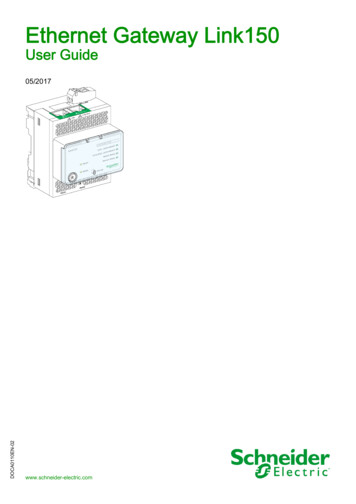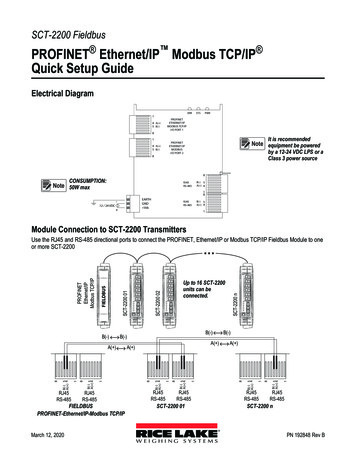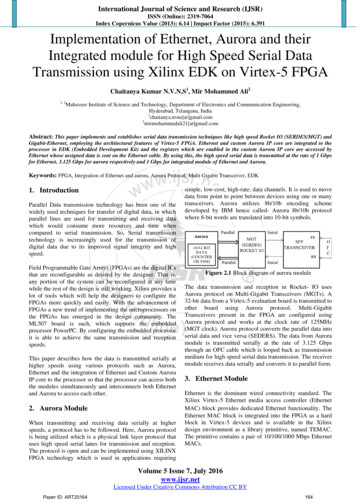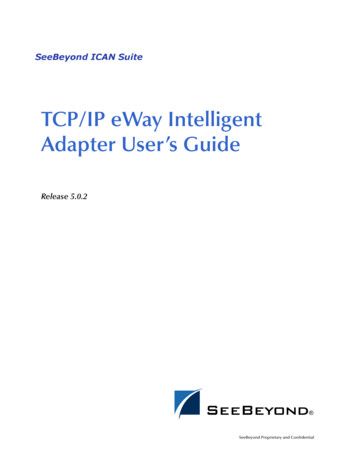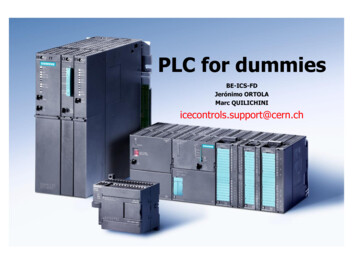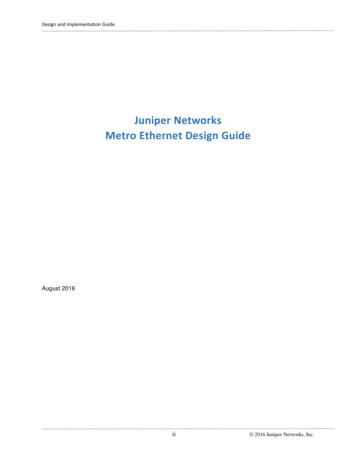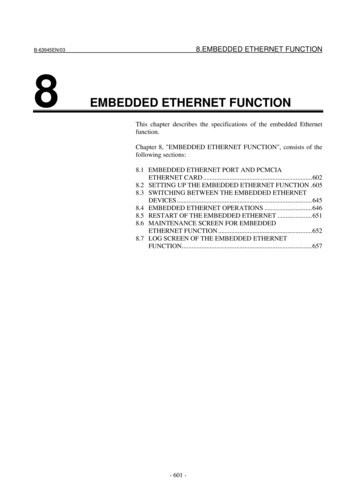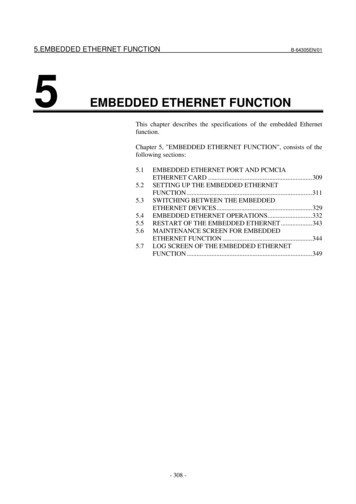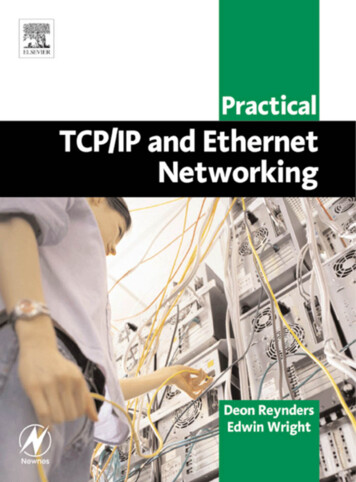
Transcription
Practical TCP/IP andEthernet Networking
Titles in the seriesPractical Cleanrooms: Technologies and Facilities (David Conway)Practical Data Acquisition for Instrumentation and Control Systems (John Park,Steve Mackay)Practical Data Communications for Instrumentation and Control (Steve Mackay,Edwin Wright, John Park)Practical Digital Signal Processing for Engineers and Technicians (Edmund Lai)Practical Electrical Network Automation and Communication Systems (CobusStrauss)Practical Embedded Controllers (John Park)Practical Fiber Optics (David Bailey, Edwin Wright)Practical Industrial Data Networks: Design, Installation and Troubleshooting (SteveMackay, Edwin Wright, John Park, Deon Reynders)Practical Industrial Safety, Risk Assessment and Shutdown Systems forInstrumentation and Control (Dave Macdonald)Practical Modern SCADA Protocols: DNP3, 60870.5 and Related Systems (GordonClarke, Deon Reynders)Practical Radio Engineering and Telemetry for Industry (David Bailey)Practical SCADA for Industry (David Bailey, Edwin Wright)Practical TCP/IP and Ethernet Networking (Deon Reynders, Edwin Wright)Practical Variable Speed Drives and Power Electronics (Malcolm Barnes)
Practical TCP/IP andEthernet NetworkingDeon Reynders Pr Eng, BSc BEng, BSc Eng (Elec)(Hons), MBAEdwin Wright MIPENZ, BSc(Hons), BSc(Elec Eng), IDC Technologies, Perth,Australia.
NewnesAn imprint of ElsevierLinacre House, Jordan Hill, Oxford OX2 8DP200 Wheeler Road, Burlington, MA 01803First published 2003Copyright 2003, IDC Technologies. All rights reservedNo part of this publication may be reproduced in any material form (includingphotocopying or storing in any medium by electronic means and whetheror not transiently or incidentally to some other use of this publication) withoutthe written permission of the copyright holder except in accordance with theprovisions of the Copyright, Designs and Patents Act 1988 or under the terms ofa licence issued by the Copyright Licensing Agency Ltd, 90 Tottenham Court Road,London, England W1T 4LP. Applications for the copyright holder’s writtenpermission to reproduce any part of this publication should be addressedto the publisherBritish Library Cataloguing in Publication DataA catalogue record for this book is available from the British LibraryISBN 07506 58061For information on all Newnes publications, visitour website at www.newnespress.comTypeset and Edited by Vivek Mehra, Mumbai, India(vivekmehra@tatanova.com)Printed and bound in Great Britain
6XKLGIK )UTZKTZY \OO 1/TZXUJ[IZOUT ZU IUSS[TOIGZOUTY 1.11.2Data communicationsTransmitters, receivers and communication channels12 1.31.41.5Types of communication channels4 1.7'TGRUM IUSS[TOIGZOUT INGTTKRY Communications channel properties4 9OMTGR GZZKT[GZOUT )NGTTKR HGTJ]OJZN 4UOYK Data transmission modes 1.6/TZKXLGIK YZGTJGXJY )UJOTM 6XUZUIURY 9USK IUSSUTR [YKJ IUSS[TOIGZOUTY VXUZUIURY *OXKIZOUT UL YOMTGR LRU] 9 TINXUTO GZOUT UL JOMOZGR JGZG YOMTGRY 'Y TINXUTU[Y ZXGTYSOYYOUT 9 TINXUTU[Y ZXGTYSOYYOUT 8 Encoding methods12 3GTINKYZKX *OLLKXKTZOGR 3GTINKYZKX 8@ XKZ[XT ZU KXU 48@ TUT XKZ[XT ZU KXU 32: ( ( Error detection14 ) IROI XKJ[TJGTI INKIQ )8) 24KZ]UXQOTM L[TJGSKTZGRY 2.12.2OverviewNetwork communication1516 2.3)OXI[OZ Y]OZINOTM 6GIQKZ Y]OZINOTM *GZGMXGSY GTJ \OXZ[GR IOXI[OZY Types of networks18 2UIGR GXKG TKZ]UXQY 2'4Y OJK GXKG TKZ]UXQY '4Y 3KZXUVUROZGT GXKG TKZ]UXQY 3'4Y
vi Contents 2.42.52.62.72.82.92.102.112.122.13)U[VROTM XGZOU OXZ[GR VXO\GZK TKZ]UXQY 64Y The open systems interconnection model20 5VKT GTJ IRUYKJ Y YZKSY :NK UVKT Y YZKSY OTZKXIUTTKIZOUT XKLKXKTIK SUJKR 59/ SUJKR 59/ RG KX YKX\OIKY 'VVROIGZOUT RG KX 6XKYKTZGZOUT RG KX 9KYYOUT RG KX :XGTYVUXZ RG KX 4KZ]UXQ RG KX *GZG ROTQ RG KX 6N YOIGR RG KX Interoperability and internetworkingProtocols and protocol standardsIEEE/ISO standardsNetwork topologies28303133 (XUGJIGYZ GTJ VUOTZ ZU VUOTZ ZUVURUMOKY 2UMOIGR GTJ VN YOIGR ZUVURUMOKY Bus topologyStar topologyRing topologyOther types of topology35363638 9ZGX ]OXKJ XOTM ZUVURUM *OYZXOH[ZKJ YZGX ZUVURUM 3KYN ZUVURUM :XKK ZUVURUM Media access methods40 )UTZKTZOUT Y YZKSY :UQKT VGYYOTM 6URROTM 3 ZNKXTKZ TKZ]UXQY 3.13.2IEEE 802.3 CSMA/CD (‘Ethernet’)Physical layer4344 3.33.4 (GYK Y YZKSY (GYK Y YZKSY (GYK: (GYK, (XUGJ (GYK Signaling methodsMedium access control 5050
Contents vii3.53.63.73.83.93.103.11Frame transmissionFrame receptionCollisionsMAC frame formatDifference between 802.3 and EthernetReducing collisionsEthernet design rules51515253555555 2KTMZN UL ZNK IGHRK YKMSKTZ 3G OS[S ZXGTYIKO\KX IGHRK RKTMZN 4UJK VRGIKSKTZ X[RKY 3G OS[S ZXGTYSOYYOUT VGZN 3G OS[S TKZ]UXQ YO K 8KVKGZKX X[RKY )GHRK Y YZKS MXU[TJOTM 4,GYZ GTJ MOMGHOZ ZNKXTKZ Y YZKSY 4.1Achieving higher speed59 4.24.34.44.5)GHROTM ROSOZGZOUTY 100Base-T (100Base-TX, -T4, -FX, -T2)60 / [ (GYK : YZGTJGXJY GXXGTMKSKTZ 6N YOIGR SKJO[S OTJKVKTJKTZ 6.? Y[HRG KX (GYK : GTJ , VN YOIGR SKJOG JKVKTJKTZ 63* Y[HRG KX (GYK : VN YOIGR SKJOG JKVKTJKTZ 63* Y[HRG KX (GYK : (GYK : N[HY (GYK : GJGVZKXY Fast Ethernet design considerations65 ;:6 IGHROTM JOYZGTIKY (GYK : : ,OHKX UVZOI IGHRK JOYZGTIKY (GYK , (GYK : XKVKGZKX X[RKY 9GSVRK IGRI[RGZOUT Gigabit Ethernet 1000Base-T67 -OMGHOZ ZNKXTKZ Y[SSGX -OMGHOZ ZNKXTKZ 3') RG KX 6N YOIGR SKJO[S OTJKVKTJKTZ 6.? Y[HRG KX (GYK 9 LUX NUXO UTZGR LOHKX (GYK 2 LUX \KXZOIGR HGIQHUTK IGHROTM (GYK ) LUX IUVVKX IGHROTM (GYK : LUX IGZKMUX ;:6 -OMGHOZ ZNKXTKZ L[RR J[VRK XKVKGZKXY Gigabit Ethernet design considerations71 ,OHKX UVZOI IGHRK JOYZGTIKY -OMGHOZ XKVKGZKX X[RKY
viii Contents5/TZXUJ[IZOUT ZU :)6 /6 5.15.25.3The origins of TCP/IPThe ARPA model vs the OSI modelThe TCP/IP protocol suite vs the ARPA model6/TZKXTKZ RG KX VXUZUIURY 6.16.2OverviewInternet protocol version 4 (IPv4)7879 6.3Internet protocol version 6 (IPv6/IPng) 6.46.56.69U[XIK UL /6 GJJXKYYKY :NK V[XVUYK UL ZNK /6 GJJXKYY /6\ GJJXKYY TUZGZOUT 4KZ]UXQ /* GTJ NUYZ /* 'JJXKYY IRGYYKY *KZKXSOTOTM ZNK GJJXKYY IRGYY H OTYVKIZOUT 4[SHKX UL TKZ]UXQY GTJ NUYZY VKX GJJXKYY IRGYY 9[HTKZ SGYQY 9[HTKZZOTM 6XO\GZK \Y /TZKXTKZ [TOW[K /6 GJJXKYYKY )RGYYRKYY GJJXKYYOTM )RGYYRKYY OTZKX JUSGOT XU[ZOTM )/*8 /6\ NKGJKX YZX[IZ[XK 6GIQKZ LXGMSKTZGZOUT /TZXUJ[IZOUT /6\ U\KX\OK] /6\ NKGJKX LUXSGZ /6\ K ZKTYOUTY /6\ GJJXKYYKY ,RU] RGHKRY 74757594 Address resolution protocol (ARP)103 'JJXKYY XKYUR[ZOUT IGINK '86 NKGJKX 6XU '86 -XGZ[OZU[Y '86 Reverse address resolution protocol (RARP)Internet control message protocol (ICMP)106107 /)36 SKYYGMK YZX[IZ[XK /)36 GVVROIGZOUTY 9U[XIK W[KTIN 8KJOXKIZOUT SKYYGMKY :OSK K IKKJKJ SKYYGMKY 6GXGSKZKX VXUHRKS SKYYGMKY ;TXKGINGHRK JKYZOTGZOUT
Contents ix 6.76.86.9/)36 W[KX SKYYGMKY Routing protocols114 8U[ZOTM HGYOIY *OXKIZ \Y OTJOXKIZ JKRO\KX 9ZGZOI \KXY[Y J TGSOI XU[ZOTM '[ZUTUSU[Y Y YZKSY /TZKXOUX K ZKXOUX GTJ MGZK]G ZU MGZK]G VXUZUIURY Interior gateway protocolsExterior gateway protocols (EGP’s)117120 (-6 7.UYZ ZU NUYZ ZXGTYVUXZ RG KX VXUZUIURY 7.1TCP (transmission control protocol)123 7.2(GYOI L[TIZOUTY 6UXZY 9UIQKZY 9KW[KTIK T[SHKXY 'IQTU]RKJMSKTZ T[SHKXY 9ROJOTM ]OTJU]Y YZGHROYNOTM G IUTTKIZOUT )RUYOTM G IUTTKIZOUT :NK V[YN UVKXGZOUT 3G OS[S YKMSKTZ YO K :NK :)6 LXGSK UDP (user datagram protocol)131 (GYOI L[TIZOUTY :NK ;*6 LXGSK 8'VVROIGZOUT RG KX VXUZUIURY 8.18.2IntroductionFile transfer protocol (FTP)133134 8.38.48.58.68.7/TZKXTGR ,:6 IUSSGTJY ,:6 [YKX IUSSGTJY 'TUT SU[Y ,:6 Trivial file transfer protocol (TFTP)137 /TZXUJ[IZOUT ,XGSK Z VKY TELNET (telecommunications network)RLOGIN (remote login)NFS (network file system)DNS (domain name system)140143143144 4GSK XKYUR[ZOUT [YOTM NUYZY LORKY
x Contents 8.8WINS 8.98.108.118.128.134GSK XKYUR[ZOUT [YOTM *49 149/TZXUJ[IZOUT /49 TGSK XKMOYZXGZOUT /49 TGSK XKYUR[ZOUT /49 VXU GMKTZY SNMP (simple network management protocol)150 9436 HGYOI IUSVUTKTZY 9436 HGYOI IUSSGTJY 9436 SGTGMKSKTZ OTLUXSGZOUT HGYK 3/( 9436\ VXUZUIUR UVKXGZOUTY 9436 SGTGMKSKTZ 9436 YKI[XOZ 9436 OTZKXUVKXGHOROZ SMTP (simple mail transfer protocol)POP (post office protocol)BOOTP (bootstrap protocol)DHCP (dynamic host configuration protocol)154155156158 *.)6 UVKXGZOUT *.)6 SKYYGMK LUXSGZ 9:)6 /6 [ZOROZOKY 9.19.29.39.49.59.69.79.89.99.10IntroductionPING (packet Internet groper)ARPNETSTATNBTSTATIPCONFIGWINIPCFGTRACE RouTeROUTEThe HOSTS file102'4 Y YZKS IUSVUTKTZY 10.110.2IntroductionRepeaters174175 10.36GIQGMOTM 2UIGR ZNKXTKZ XKVKGZKXY 8KSUZK XKVKGZKXY Media converters 162163166167167168169170172173 176
Contents xi10.4Bridges 10.5Hubs 10.6*KYQZUV \Y YZGIQGHRK N[HY 9NGXKJ \Y Y]OZINKJ N[HY 3GTGMKJ N[HY 9KMSKTZGHRK N[HY *[GR YVKKJ N[HY 3UJ[RGX N[HY .[H OTZKXIUTTKIZOUT 182)[Z ZNXU[MN \Y YZUXK GTJ LUX]GXJ 2G KX Y]OZINKY \Y RG KX Y]OZINKY ,[RR J[VRK Y]OZINKY 9]OZIN GVVROIGZOUTY Routers 179Switches 10.7177/TZKRROMKTZ HXOJMKY 9U[XIK XU[ZOTM HXOJMKY 98: GTJ ZXGTYRGZOUTGR HXOJMKY 2UIGR \Y XKSUZK HXOJMKY 186:]U VUXZ \Y S[RZO VUXZ XU[ZKXY 'IIKYY XU[ZKXY (UXJKX XU[ZKXY 8U[ZOTM \Y HXOJMOTM 10.810.910.1010.1110.1210.13GatewaysPrint serversTerminal serversThin serversRemote access serversNetwork timeservers11:NK /TZKXTKZ 11.111.2The Internet and internetThe objectives, background and history of TCP/IP191191 11.311.411.5:NK UXOMOT UL :)6 GTJ /6 :NK NOYZUX GTJ HGIQMXU[TJ UL :)6 /6 187188188189189190 The Internet organizational structure192 /))( /'( / :, /8:, :NK /TZKXTKZ YUIOKZ /'( The World Wide WebAn introduction to HTML193194
xii Scripting: JavaScriptXMLServer side includesPerl19419519619619619719712/TZKXTKZ GIIKYY 12.112.212.3Connecting a single host to the InternetConnecting remote hosts to corporate LANConnecting multiple hosts to the Internet198200200 )UTTKIZOUT \OG VXU YKX\KX )UTTKIZOUT \OG 4': YKX\KX /6 SGYW[KXGJOTM )UTTKIZOUT \OG /6 YNGXKX )UTTKIZOUT \OG ;4/ UX 4: MGZK]G )UTTKIZOUT \OG JKJOIGZKJ XU[ZKX 13:NK /TZKXTKZ LUX ware and software issuesSpeed/bandwidth issuesLegal issuesE-mail203203204204205 13.613.7656 GTJ 93:6 YKX\KXY SGOR YULZ]GXK XKYOJOTM UT ZNK RUIGR NUYZ ]UXQYZGZOUT SGOR YULZ]GXK XKYOJOTM UT G XKSUZK YKX\KX UOIK XKZXOK\GR UL K SGOR Internet telephony206 /TZXUJ[IZOUT 6) ZU 6) 6) ZU VNUTK 6NUTK ZU VNUTK 3O KJ 6) VNUTK ZU SO KJ 6) VNUTK ]OZN OTZXGTKZ 6( /TIUSOTM IGRRY ]OZN IGRR ]GOZOTM 5[ZMUOTM IGRRY ]OZN XKM[RGX VNUTK ZNXU[MN 6) 2O\K \UOIK IUSS[TOIGZOUT ]OZN I[YZUSKXY \OG ]KH VGMK 9KI[XK VNUTKY Paging 209939 YNUXZ SKYYGMK YKX\OIK *'0*YUIQ
Contents xiii13.813.9Voice mail210 Fax 13.1013.11211,G SGINOTK K SGOR ZU LG SGINOTK K SGOR ,G SGINOTK ZU LG SGINOTK Video conferencing211 OJKU G[JOU JUI[SKTZ IUTLKXKTIOTM OJKU TKZ]UXQOTM News 13.126) ZU 6) 2124K]Y V[YN 4K]Y V[RR 4K]Y MXU[VY ;9 4 : 9KGXIN GMKTZY Additional information214 /TZKXTKZ ZKRKVNUT OJKU IUTLKXKTIOTM 6GMOTM ,G UOIK IUSS[TOIGZOUT \OG ]KH VGMK ROTQ UOIK SGOR 4K]Y YKX\OIKY 666 YKX\KXY SGOR 149KI[XOZ IUTYOJKXGZOUTY 14.114.2The security problemControlling access to the network216218 '[ZNKTZOIGZOUT 8U[ZKXY ,OXK]GRRY Intrusion detection systems (IDS)223 14.314.414.514.6.UYZ HGYKJ /*9 4KZ]UXQ HGYKJ /*9 Security management224 )KXZOLOIGZOUT /TLUXSGZOUT YKI[XOZ VUROIOKY 9KI[XOZ GJ\OYUX YKX\OIKY The public key infrastructure (PKI)227 /TZXUJ[IZOUT ZU IX VZUMXGVN TIX VZOUT GTJ JOMOZGR YOMTGZ[XK K VRGOTKJ 61/ JKLOTOZOUT V[HROI QK OTLXGYZX[IZ[XK 61/ L[TIZOUTY References232 /TZKXTKZ K ZXGTKZ OTZXGTKZ YKI[XOZ
xiv Contents TIX VZOUT ,OXK]GRRY VXU YKX\KXY KZI 156XUIKYY G[ZUSGZOUT 15.115.215.3BackgroundLegacy automation architecturesThe factory of the future234234236 15.4:NK TKZ]UXQOTM VXUZUIUR YZGIQ 'VVROIGZOUT RG KX JGZG YZX[IZ[XKY SHKJJKJ ]KH YKX\KXY 8U[ZKXY GTJ Y]OZINKY 4KZ]UXQ GIIKYY :NOT YKX\KXY 4KZ]UXQ IGVGHRK GVVROIGZOUT VXUIKYYUXY 4)'6Y ZNKXTKZ IUSVGZOHRK 62)Y ZNKXTKZ IUSVGZOHRK 9)'*' Y YZKSY References241 '[ZUSGZOUT ZXKTJY :)6 /6 HGYKJ LGIZUX G[ZUSGZOUT :NOT YKX\KXY KH IUSVGZOHRK 9)'*' Y YZKSY 0G\G 16/TYZGRROTM GTJ ZXU[HRKYNUUZOTM ZNKXTKZ Y YZKSY 16.1Network drivers243 16.216.316.416.516.616.74KZ]UXQ JXO\KXY )USVGZOHOROZ GTJ [YGMK Network card/driver configurationNetwork driver interface specification (NDIS)Open data link interface (ODI)Packet driversPlug and play architecturePCMCIA interface244245245246246246 /TZXUJ[IZOUT 6)3)/' OTZKXLGIK 16.8Protocol analyzers17:XU[HRKYNUUZOTM :)6 /6 17.117.2Maintenance and troubleshooting of real TCP/IP networksNetwork troubleshooting249250 /TIXKGYOTM T[SHKX UL IURROYOUTY UT ZNK ZNKXTKZ TKZ]UXQ 247
Contents xv 17.34KZ]UXQ [ZORO GZOUT RU] H[Z KXXUXY NOMN .OMN T[SHKX UL VGIQKZY H[Z RU] JGZG ZXGTYLKXY Troubleshooting with TCP/IP utilities251 GSVRK UL [YK UL G LK] UL ZNK [ZOROZOKY ZUMKZNKX ;TXKROGHRK IUTTKIZOUTY 4KZ]UXQ IUTMKYZOUT 189GZKRROZKY GTJ :)6 /6 18.118.218.318.4IntroductionOverview of satellite communicationsAdvantages of satellite networksApplications of satellite systems255255258259 18.518.618.78KSUZK IUTZXUR GTJ RUMOT OJKU IUTLKXKTIOTM RKIZXUTOI SGOR /TLUXSGZOUT XKZXOK\GR ([RQ OTLUXSGZOUT HXUGJIGYZOTM /TZKXGIZO\K MGSOTM Review of TCP/IP261 /TZKXTKZ VXUZUIUR UX /6 VXUZUIUR :XGTYSOYYOUT IUTZXUR VXUZUIUR UX :)6 Weaknesses of TCP/IP in satellite usage265 OTJU] YO K ZUU YSGRR (GTJ]OJZN GJGVZGZOUT 9KRKIZO\K GIQTU]RKJMSKTZ 9RU] YZGXZ :)6 LUX ZXGTYGIZOUTY Methods of optimizing TCP/IP over satellite channels266Appendix A: -RUYYGX Appendix B: 6UXZ T[SHKX GRRUIGZOUT /TJK
PrefaceOne of the great protocols that has been inherited from the Internet is TCP/IP and this is being used asthe open standard today for all network and communications systems. The reasons for this popularityare not hard to find. TCP/IP and Ethernet are truly open standards available to competingmanufacturers and providing the user with a common standard for a variety of products from differentvendors. In addition, the cost of TCP/IP and Ethernet is low. Initially TCP/IP was used extensively inmilitary applications and the purely commercial world such as banking, finance, and general business.But of great interest has been the strong movement to universal usage by the hitherto disinterestedindustrial and manufacturing spheres of activity who have traditionally used their own proprietaryprotocols and standards. These proprietary standards have been almost entirely replaced by the usageof the TCP/IP suite of protocols.This is a hands-on book that has been structured to cover the main areas of TCP/IP and Ethernet indetail, while going through the practical implementation of TCP/IP in computer and industrialapplications. Troubleshooting and maintenance of TCP/IP networks and communications systems inan office and industrial environment will also be covered.After reading this book we would hope you would be able to: Understand the fundamentals of the TCP/IP suite of protocolsGain a practical understanding of the application of TCP/IPLearn how to construct a robust local area network (LAN)Learn the basic skills in troubleshooting TCP/IP and LANsApply the TCP/IP suite of protocols to both an office and industrialenvironmentTypical people who will find this book useful include: Network techniciansData communications managersCommunication specialistsIT support managers and personnelNetwork plannersProgrammersDesign engineersElectrical engineersInstrumentation and control engineersSystem integratorsSystem analystsDesignersIT and MIS managersNetwork support staffSystems engineersYou should have a modicum of computer knowledge and know how to use the Microsoft Windowsoperating system in order to derive maximum benefit from this book.
xviii PrefaceThe structure of the book is as follows.Chapter 1: Overview. This chapter gives a brief overview of what is covered in the book with anoutline of the essentials of communications systems.Chapter 2: Networking fundamentals. An overview of network communication, types ofnetworks, the OSI model, network topologies and media access methods.Chapter 3: Ethernet networks. A description of the operation and performance of Ethernetnetworks commencing with the basic principles.Chapter 4: Fast and gigabit Ethernet Systems. A minimum speed of 100 Mbps is becomingde rigeur on most Ethernet networks and this chapter examines the design and installation issues forfast Ethernet and gigabit Ethernet systems, which go well beyond the traditional 10 Mbps speed ofoperation.Chapter 5: Introduction to TCP/IP. A brief review of the origins of TCP/IP to lay thefoundation for the following chapters.Chapter 6: Internet layer protocols. Perhaps the workhorse of the TCP/IP suite of protocols thischapter fleshes out the Internet protocol (both Ipv4 and Ipv6) and also examines the operation of ARP,RARP and ICMP.Chapter 7: Host-to-host (transport) layer protocols. The TCP (transmission control protocol)and UDP (user datagram protocol) are both covered in this chapter.Chapter 8: Application layer protocols. A thorough coverage of the most important applicationlayer protocols such as FTP (file transfer protocol), TFTP (trivial file transfer protocol), TELNET,Rlogin, network file system, domain name system, WINS, simple network management protocol(SNMP), SMTP, POP, BOOTP and DHCP.Chapter 9: TCP/IP utilities. A coverage focussing on the practical application of the mainutilities such as Ping, ARP, NETSTAT NBTSTAT, IPCONFIG, WINIPCFG, tracert, ROUTE and thehosts file.Chapter 10: LAN system components. A discussion on the key components in connectingnetworks together such as repeaters, bridges, switches and routers.Chapter 11: The Internet. A brief discussion on the origins of the Internet and the variousassociated standards organizations.Chapter 12: Internet access. The typical methods of connecting to the Internet are outlined herewith a discussion on connecting a single host to the Internet, connecting multiple remote hosts to acorporate LAN, and in connecting multiple hosts to the Internet.Chapter 13: The Internet for communications. Speed/bandwidth issues, the different optionsfor E-mail, voice over IP and voice mail will be described in this chapter.
Preface xixChapter 14: Security considerations. The security problem and methods of controlling accessto a network will be examined in this chapter. This is a growing area of importance due to theproliferation attacks on computer networks by external parties.Chapter 15: Process automation. The legacy architectures and the factory of the future will beexamined here together with an outline of the key elements of the modern Ethernet and TCP/IParchitecture.Chapter 16: Installing and troubleshooting Ethernet systems. The functions of the varioustypes of network driver software together with the parameters to set the network card to match up tothe software for correct operation will be described here.Chapter 17: Troubleshooting TCP/IP. Maintenance of a TCP/IP network together with threetypical methods requiring troubleshooting and the use of the utilities such as NETSTAT, Ping, tracert,and ripquery.Chapter 18: Satellites and TCP/IP. An overview of satellites and TCP/IP with satellites.
1/TZXUJ[IZOUT ZU IUSS[TOIGZOUTY 5HPKIZO\KY When you have completed study of this chapter you should be able to: Understand the main elements of the data communication process Understand the difference between analog and digital transmission Explain how data transfer is affected by attenuation, bandwidth and noise inthe channel Know the importance of synchronization of digital data systems Describe the basic synchronization concepts used with asynchronous andsynchronous systems Explain the following types of encoding: Manchester RZ NRZ MLT-3 4B/5B Describe the basic error detection principles. *GZG IUSS[TOIGZOUTY Communications systems exist to transfer information from one location to another. Thecomponents of the information or message are usually known as data (derived from theLatin word for items of information). All data are made up of unique code symbols orother entities on which the sender and receiver of the messages have agreed. For examplebinary data is represented by two states ‘0’ and ‘1’. These are referred to as Binary digiTSor ‘bits’. These bits are represented inside our computers by the level of the electrical
6XGIZOIGR :)6 /6 GTJ ZNKXTKZ 4KZ]UXQOTM signals within storage elements; a high level could represent a ‘1’, and a low-levelrepresent a ‘0’. Alternatively, the data may be represented by the presence or absence oflight in an optical fiber cable. :XGTYSOZZKXY XKIKO\KXY GTJ IUSS[TOIGZOUT INGTTKRY A communications process requires the following components: A source of the information A transmitter to convert the information into data signals compatible withthe communications channel A communications channel A receiver to convert the data signals back into a form the destination canunderstand The destination of the informationThis process is shown in Figure 1.1.Figure 1.1Communications processThe transmitter encodes the information into a suitable form to be transmitted over thecommunications channel. The communications channel moves this signal aselectromagnetic energy from the source to one or more destination receivers. Thechannel may convert this energy from one form to another, such as electrical to opticalsignals, whilst maintaining the integrity of the information so the recipient can understandthe message sent by the transmitter.For the communications to be successful the source and destination must use a mutuallyagreed method of conveying the data.The main factors to be considered are: The form of signaling and the magnitude(s) of the signals to be used The type of communications link (twisted pair, coaxial, optic fiber, radio etc) The arrangement of signals to form character codes from which the messagecan be constructed The methods of controlling the flow of data The procedures for detecting and correcting errors in the transmissionThe form of the physical connections is defined by interface standards, some agreedcoding is applied to the message and the rules controlling the data flow and detection andcorrection of errors are known as the protocol. /TZKXLGIK YZGTJGXJY An interface standard defines the electrical and mechanical aspects of the interface toallow the communications equipment from different manufacturers to operate together.A typical example is the EIA/TIA-232-E interface standard. This specifies thefollowing three components:
/TZXUJ[IZOUT ZU IUSS[TOIGZOUTY Electrical signal characteristics – defining the allowable voltage levels,grounding characteristics etc Mechanical characteristics – defining the connector arrangements and pinassignments Functional description of the interchange circuits – defining the functionof the various data, timing and control signals used at the interfaceIt should be emphasized that the interface standard only defines the electrical andmechanical aspects of the interface between devices and does not cover how data istransferred between them. )UJOTM A wide variety of codes have been used for communications purposes. Early telegraphcommunications used Morse code with human operators as transmitter and receiver. TheBaudot code introduced a constant 5-bit code length for use with mechanical telegraphtransmitters and receivers. The commonly used codes for data communications today arethe Extended Binary Coded Decimal Interchange Code (EBCIDIC) and the AmericanStandards Committee for Information Interchange (ASCII). 6XUZUIURY A protocol is essential for defining the common message format and procedures fortransferring data between all devices on the network. It includes the following importantfeatures: Initialization: Initializes the protocol parameters and commences the datatransmission Framing and synchronization: Defines the start and end of the frame andhow the receiver can synchronize to the data stream Flow control: Ensures that the receiver is able to advise the transmitter toregulate the data flow and ensure no data is lost. Line control: Used with half-duplex links to reverse the roles of transmitterand receiver and begin transmission in the other direction. Error control: Provides techniques to check the accuracy of the receiveddata to identify transmission errors. These include Block Redundancy checksand cyclic redundancy checks Time out control: Procedures for transmitters to retry or abort transmissionwhen acknowledgments are not received within agreed time limits 9USK IUSSUTR [YKJ IUSS[TOIGZOUTY VXUZUIURY Xmodem or Kermit for asynchronous file transmission Binary synchronous protocol (BSC), synchronous data link control (SDLC)or high level data link control (HDLC) for synchronous transmissions Industrial protocols such as manufacturing automation protocol (MAP),technical office protocol (TOP), Modbus, Data Highway Plus, HART,Profibus, Foundation Fieldbus, etc
6XGIZOIGR :)6 /6 GTJ ZNKXTKZ 4KZ]UXQOTM : VKY UL IUSS[TOIGZOUT INGTTKRY 'TGRUM IUSS[TOIGZOUTY INGTTKRY An analog communications channel conveys analog signals that are changingcontinuously in both frequency and amplitude. These signals are commonly used foraudio and video communication as illustrated in Figure 1.2 and Figure 1.3.Figure 1.2Analog signalFigure 1.3Digital signal )USS[TOIGZOUT INGTTKR VXUVKXZOKY 9OMTGR GZZKT[GZOUT As the signal travels along a communications channel its amplitude decreases as thephysical medium resists the flow of the electromagnetic energy. This effect is known assignal attenuation. With electrical signaling some materials such as copper are veryefficient conductors of electrical energy. However, all conductors contain impurities that
/TZXUJ[IZOUT ZU IUSS[TOIGZOUTY resist the movement of the electrons that constitute the electric current. The resistance ofthe conductors causes some of the electrical energy of the signal to be converted to heatenergy as the signal progresses along the cable resulting in a continuous decrease in theelectrical signal. The signal attenuation is measured in terms of signal loss per unit lengthof the cable, typically dB/km.Figure 1.4Signal attenuationTo allow for attenuation, a limit is set for the maximum length of the communicationschannel. This is to ensure that the attenuated signal arriving at the receiver is of sufficientamplitude to be reliably detected and correctly interpreted. If the channel is longer thanthis maximum length, amplifiers or repeaters must be used at intervals along the channelto restore the signal to acceptable levels.Figure 1.5Signal repeatersSignal attenuation increases as the frequency increases. This causes distortion topractical signals containing a range of frequencies. This is illustrated in Figure 1.4 wherethe rise-times of the attenuated signals progressively decrease as the signal travelsthrough the channel, caused by the greater attenuation of the high frequency components.This problem can be overcome by the use of amplifiers that amplify the higherfrequencies by greater amounts.
6XGIZOIGR :)6 /6 GTJ ZNKXTKZ 4KZ]UXQOTM )NGTTKR HGTJ]OJZN The
Practical TCP/IP and Ethernet Networking (Deon Reynders, Edwin Wright) Practical Variable Speed Drives and Power Electronics (Malcolm Barnes) Practical TCP/IP and . This is a hands-on book that has been structured to c
